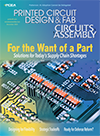Automating First Article Inspection to Improve Accuracy and Speed Changeover
 A Lean solution for high-mix production environments.
A Lean solution for high-mix production environments.
In any manufacturing process, first article inspection (FAI) plays a crucial role in validating initial assumptions about product design, manufacturability, materials, process design, machine programming and process control. This validation ensures consistency before the production of the product in volume. In the electronics manufacturing services (EMS) world, this process is often more complex because of the number of parties involved.
Typically, the customer dictates product and process, while third-party regulatory requirements may also apply. The customer provides documentation and supporting machine programming, while the EMS provider manages the supply chain based on the approved material list (AML) supplied by the customer. Customer and EMS provider teams collaborate on process development and validation.
In this situation, first article inspection is not only a critical step in validating design assumptions, but also an opportunity to provide feedback on learning curve issues and eliminate defect opportunities prior to volume production. Additionally, some form of FAI is required at the beginning of each production lot. OEMs and regulatory requirements dictate the content and structure of most FAIs. Product quality inspection focuses on both workmanship and parts critical to product quality. Manual first article inspection reports (FAIR) for complex products can be time consuming. Similarly, manual FAI performed as part of line changeover can significantly slow down the changeover process.
Last year, SigmaTron International’s facility in Suzhou added an automated FAI system. Bill of materials (BoM) and X-Y data are imported and the documentation analyzed for consistency. If everything is correct, the program shows a pass screen. If inconsistencies are found, a fail screen pops up with the inconsistencies flagged in red type. The next step is optical character recognition (OCR) inspection of resistors. The machine scans the component markings and compares them to its library. If library data have a discrepancy, the machine shows a picture of the portion of the printed circuit board assembly (PCBA) with the questionable part(s) flagged with red lines. It then performs optical character verification (OCV) testing on integrated circuits (ICs) or other relevant components, provided the parts library has been set up with inspection requirements tracking to component marking. Test results appear in spreadsheet format, showing pass or fail tracking for individual parts by reference designator and x, y coordinates. OCR/OCV capabilities enable the system to verify component markings for component value, polarity, manufacturer part number and more. Additionally, the machine can test inductance, capacitance and resistance (LCR) and light-emitting diodes (LEDs). The electrical testing checks capacitors and resistors. The LED test measures diode polarity. While supporting a wide variety of test and inspection requirements, the machine cannot test for solder workmanship quality. For such inspections, automated optical inspection (AOI) or manual inspection is necessary. From a Lean perspective, automating FAIR reporting mitigates defects. The largest benefit, however, occurs in the use of automated FAI during line changeover, where single minute exchange of die (SMED) focuses on reducing the time associated with changeover, positively affecting line utilization metrics. When a line changes over to a new production lot, inspection of the first board before starting volume production determines the length of changeover time.
Internal studies have shown that, even when solder joint workmanship is inspected manually, the automated FAI system is five times faster than manual inspection. Reducing changeover time helps maximize SMT utilization, improving overall equipment effectiveness (OEE) in high-mix production environments. Additionally, it is user-friendly, enabling fast programming and analysis. It also requires a single operator, while manual inspection generally requires at least two operators. Another Lean benefit is that automated FAI enhances accuracy, repeatability and effectiveness in visual inspection. It is particularly beneficial in situations with small-form factor components or high-density designs.
One of the biggest benefits is its ability to provide documentation required for traceability and device history recordkeeping. The automated FAI system can provide a detailed PDF FAIR file which includes the full inspection report by line item, photos of specific components, a photo of the PCBA and any associated manual inspection records. Similarly, when used in for changeover FAI, it automates inspection report generation, enabling tracking of entire the inspection process.
The FAI system also benefits quality control activities by identifying any missing device designators on the printed circuit board (PCB) silkscreen. Overall, automating the FAI process ensures repeatability, accelerates inspection and delivers a more comprehensive FAIR. In high-mix production environments, it can also significantly reduce line changeover time, reduce labor requirements and provide more comprehensive inspection records.
is vice president, China operations at SigmaTron (sigmatronintl.com); homming.chang@sigmatronintl.com.







